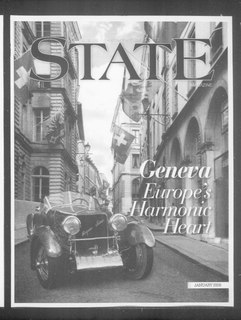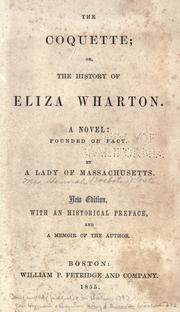Related Research Articles

A magazine is a periodical publication, generally published on a regular schedule, containing a variety of content. They are generally financed by advertising, by a purchase price, by prepaid subscriptions, or by a combination of the three.

John Nichols was an English printer, author and antiquary. He is remembered as an influential editor of the Gentleman's Magazine for nearly 40 years; author of a monumental county history of Leicestershire; author of two compendia of biographical material relating to his literary contemporaries; and as one of the agents behind the first complete publication of Domesday Book in 1783.

A small press is a publisher with annual sales below a certain level or below a certain number of titles published. The terms "indie publisher" and "independent press" and others are sometimes used interchangeably.

The Coquette or, The History of Eliza Wharton is an epistolary novel by Hannah Webster Foster. It was published anonymously in 1797, and did not appear under the author's real name until 1856, 16 years after Foster's death. It was one of the best-selling novels of its time and was reprinted eight times between 1824 and 1828. A fictionalized account of the much-publicized death of a socially elite Connecticut woman after giving birth to a stillborn, illegitimate child at a roadside tavern, Foster's novel highlights the social conditions that lead to the downfall of an otherwise well-educated and socially adept woman.

The American Antiquarian Society (AAS), located in Worcester, Massachusetts, is both a learned society and a national research library of pre-twentieth-century American history and culture. Founded in 1812, it is the oldest historical society in the United States with a national focus. Its main building, known as Antiquarian Hall, is a U.S. National Historic Landmark in recognition of this legacy. The mission of the AAS is to collect, preserve and make available for study all printed records of what is now known as the United States of America. This includes materials from the first European settlement through the year 1876.
Frances Harriet Whipple Green McDougall (1805–1878) was an abolitionist, poet, novelist, editor, botanist, spiritualist medium, and advocate of women's, voters', and workers' rights. In contrast to many other 19th-century women writers, throughout most of her adult life she earned her living as an author; at the same time she often donated her writing for causes she believed in, such as the abolition of slavery. She stands out in History of Rhode Island.

Susanna Rowson, née Haswell was an American novelist, poet, playwright, religious writer, stage actress, and educator, considered the first woman geographer and supporter of female education. She also wrote against slavery. Rowson was the author of the 1791 novel Charlotte Temple, the most popular best-seller in American literature until Harriet Beecher Stowe's Uncle Tom's Cabin was published serially in 1851-1852 and authored the first human geography textbook Rowson's Abridgement of Universal Geography in 1805.

The Medical Repository was the first American medical journal, founded in 1797 and published quarterly, with some interruptions, through 1824.

The Analytical Review was an English periodical that was published from 1788 to 1798, having been established in London by the publisher Joseph Johnson and the writer Thomas Christie. Part of the Republic of Letters, it was a gadfly publication, which offered readers summaries and analyses of the many new publications issued at the end of the eighteenth century.

Vice Versa (1947–1948), subtitled "America's Gayest Magazine", is the earliest known U.S. periodical published especially for lesbians. Its mission was to express lesbian emotion within the bounds of good taste.
Christian Isobel Johnstone (1781–1857) was a prolific journalist and author in Scotland in the nineteenth century. She was a significant early feminist and an advocate of other liberal causes in her era. She wrote anonymously, and under the pseudonym Margaret Dods.

The American Magazine and Historical Chronicle (1743-1746) was a periodical in Boston, Massachusetts, printed by Rogers & Fowle, and published by Samuel Eliot and Joshua Blanchard. Scholars suggest that Jeremiah Gridley served as editor.
Edmund Freeman (1764–1807) was a printer and publisher in Boston, Massachusetts, in the late 18th century. He published the Boston Magazine and the Herald of Freedom newspaper. He worked with Loring Andrews as "Freeman and Andrews, printers, State-Street, north side State-House." As editor of the Herald of Freedom, he was sued for libel in 1790 by Massachusetts legislator John Gardiner; Freeman won the case.
Eliza Anderson Godefroy is believed to be the first woman to edit a general-interest magazine in the United States. At age 26, from 1806 to 1807, she served as the founder and editor of a Baltimore publication called The Observer.

The Tatler was a British literary and society journal begun by Richard Steele in 1709 and published for two years. It represented a new approach to journalism, featuring cultivated essays on contemporary manners, and established the pattern that would be copied in such British classics as Addison and Steele's Spectator, Samuel Johnson's Rambler and Idler, and Goldsmith's Citizen of the World. The Tatler would also influence essayists as late as Charles Lamb and William Hazlitt. Addison and Steele liquidated The Tatler in order to make a fresh start with the similar Spectator, and the collected issues of Tatler are usually published in the same volume as the collected Spectator.

The Riverside Magazine For Young People was a monthly United States children’s magazine, published between January 1867 and December 1870. It was founded by Henry Oscar Houghton, who named the periodical after his former business, Riverside Press, of Cambridge, Massachusetts. The magazine was published by Hurd & Houghton in New York City and it printed stories written by Mary Mapes Dodge, Sarah Orne Jewett, Rose Terry Cooke, Hans Christian Andersen and other authors who were well known at the time. In 1871 the magazine merged with Scribner’s Monthly.

Early American publishers and printers played a central role in the social, religious, political and commercial developments in colonial America, before, during and after the American Revolution. Printing and publishing in the 17th and 18th centuries among the Thirteen Colonies of British North America first emerged as a result of religious enthusiasm and over the scarcity and subsequent great demand for bibles and other religious literature. By the mid 18th century printing took on new proportions with the newspapers that began to emerge, most notably in Boston. When the British Crown began imposing new taxes, many of these newspapers became highly critical and outspoken about the British colonial government, which was widely considered unfair among the colonists.

Bibliography of early American publishers and printers is a selection of books, journals and other publications devoted to these topics covering their careers and other activities before, during and just after the American Revolution. Various works that are not primarily devoted to those topics, but whose content devotes itself to them in significant measure, are sometimes included also. Works about Benjamin Franklin, a famous printer and publisher, among other things, are too numerous to list in this bibliography and are generally not included unless they are greatly devoted to his printing career. Single accounts of printers and publishers that occur in encyclopedia articles are neither included here.
Mark L. Kamrath is a professor of early American literature and culture at the University of Central Florida (UCF) in Orlando, Florida. He specializes in eighteenth-century American literature and culture, especially periodical literature. In particular, he is known for his work on Charles Brockden Brown, America’s first professional author (1771-1810).
References
- 1 2 Beer, William (1923). Checklist of American Periodicals, 1741-1800. The Society.
- 1 2 3 4 5 6 MURPHY, JILLMARIE (2016). ""The Humming Bird; or Herald of Taste" (1798): Periodical Culture and Female Editorship in the Early American Republic". American Periodicals. 26 (1): 44–69. ISSN 1054-7479. JSTOR 44630664.
- 1 2 Kamrath, Mark; Harris, Sharon M. (2005). Periodical Literature in Eighteenth-century America. Univ. of Tennessee Press. ISBN 978-1-57233-319-2.
- 1 2 Kamrath, Mark (2002). ""Eyes Wide Shut" and the Cultural Poetics of Eighteenth-Century American Periodical Literature". Early American Literature. 37 (3): 497–536. ISSN 0012-8163. JSTOR 25057284.
- 1 2 Kelley, Mary (2006). Learning to Stand & Speak: Women, Education, and Public Life in America's Republic. UNC Press Books. ISBN 978-0-8078-3064-2.
- ↑ Evans, Charles (1925). American Bibliography: 1793-1794. Priv. print. for the author by the Blakely Press.
- ↑ Rowson, Mrs (1905). Charlotte Temple: A Tale of Truth. Funk & Wagnalls Company. pp. ci.
- ↑ Beach, Lazarus, ed. (1798). The Humming bird, or, Herald of taste. Newfield, [Conn.]: Printed by L. Beach. OCLC 191120893.